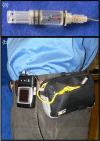Characterizing normal-use temperature conditions of pumped insulin
- PMID: 24876429
- PMCID: PMC4764209
- DOI: 10.1177/1932296814532327
Characterizing normal-use temperature conditions of pumped insulin
Abstract
In this study, the temperature profiles of insulin pump reservoirs during normal wear conditions across multiple seasons were characterized. Thermocouples secured in reservoirs filled with insulin diluent were loaded in infusion pumps worn by volunteers. Reservoir and ambient environmental temperature data and activity levels were logged during the course of normal daily activities in February (winter), April (spring), and August (summer). Each seasonal data set comprised 7 to 14 days of wear from 3 to 5 volunteers. Reservoir temperature profiles were generally higher than ambient temperatures, likely due to heat transfer from the wearer when the pump was placed close to the body. Temperature conditions inside pump reservoirs fluctuated between 25°C and 37°C regardless of seasonal variations. The average reservoir temperature remained close to 30°C across all seasons, notably lower than used in previously published compatibility and stability protocols (37°C). Results from this study could be utilized to develop more accurate stability and compatibility testing procedures for new insulin formulations and/or delivery devices.
Keywords: continuous subcutaneous insulin infusion; insulin delivery device testing; insulin pump temperature; thermal monitoring.
© 2014 Diabetes Technology Society.
Conflict of interest statement
Figures



References
-
- Senstius J, Poulsen C, Hvass A. Comparison of in vitro stability for insulin aspart and insulin glulisine during simulated use in infusion pumps. Diabetes Technol Ther. 2007;9(6):517-522. - PubMed
-
- Senstius J, Harboe E, Westermann H. In vitro stability of insulin aspart in simulated continuous subcutaneous insulin infusion using a MiniMed 508 insulin pump. Diabetes Technol Ther. 2007;9(1):75-79. - PubMed
-
- Sharrow SD, Glass LC, Dobbins MA. 14-day in vitro chemical stability of insulin lispro in the MiniMed paradigm pump. Diabetes Technol Ther. 2012;14(3):1-7. - PubMed
-
- Lougheed WD, Zinman B, Strack TR, et al. Stability of insulin lispro in insulin infusion systems. Diabetes Care. 1997;20(7):1061-1065. - PubMed
Publication types
MeSH terms
Substances
LinkOut - more resources
Full Text Sources
Other Literature Sources
Medical
Miscellaneous

